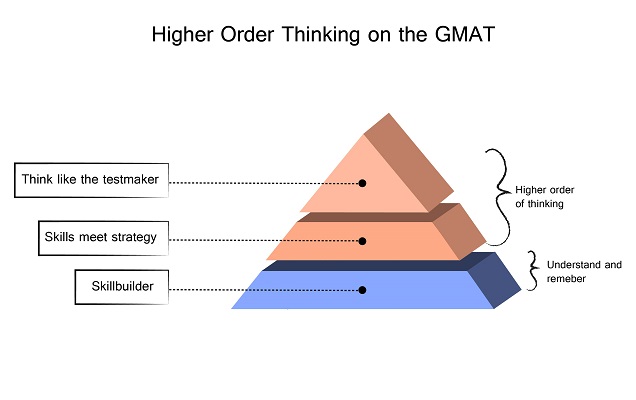But to the untrained eye, looking at the content that it tests, it may not appear to be well suited for that. The GMAT features:
Arithmetic (including division with remainders, the use of fractions, and even the mechanics of addition, subtraction, and multiplication)
Algebra (but mostly linear algebra)
Geometry (but no trigonometry)
English grammar (but a relatively small subset)
Reading comprehension (but on passages of less than 400 words; there are no legal briefs or Tolstoy novels here).
So why does a test that features content that might look primitive to even an average high school student work so well at assessing a 25-year-old college graduate's preparedness for Harvard, Stanford or London Business School?
It's not about content.

The GMAT is a test of reasoning, of "higher-order thinking". And higher-order thinking has an academic definition - it's not a buzzword like "paradigm shift" or "synergy" that could be open to interpretation. Higher-order thinking is anything beyond "Remember" and "Understand" on a list of verbs that demonstrate a student's facility with new information or concepts. Higher-order thinking means that you don't merely remember and understand that information, but you can "Apply" it to new concepts, "Analyse" it in and out of context, "Create" new information or understanding how to build off of it. Which all means that to truly succeed in the GMAT test, to achieve scores in the high 600s into the 700s, remembering those facts and formulas from high school isn't enough. It's not about whether you remember the Pythagorean Theorem or how to factor a quadratic equation; it's about whether you can apply that knowledge to unique situations that may not even seem at first glance to call for that type of knowledge.
Simply put, the GMAT is a test of how you think, not a test of what you know.
So, how can you apply this new found knowledge about the GMAT in your quest to achieve a high score?
Learn more about the GMAT Facts and Stats
Don't Just Memorise; Understand.
For many tests you've taken, memorising a list of steps and then applying them in the exam was enough to demonstrate that you can "Master" the concept. But on the GMAT test, more difficult problems are crafted expressly to make sure that you can't rely on memory alone, requiring instead that you solve new problems using familiar frameworks. (After all, isn't that business? Encountering a brand new problem and applying frameworks and historical knowledge in an attempt to solve it?)
So avoid the temptation to flip straight to the back of the book or the online solution when you can't solve a problem and then copy down, step for step, what the book says about solving it. Instead, push yourself to bridge the gap between the question and the correct answer. How should you have recognised that you needed to take that first step? Why were you tempted to, say, divide both sides by x (even though you couldn't because, alas, x could have been zero!)? What clues were in the answer choices to let you know that you didn't have to slog through the algebra and could have simply plugged in answers instead?
Many students become so mired in the "What" (they need to know) that they seldom address the "Why" (they didn't see at first what to do, or why they fell for the trap answer) or the "How" (they should have recognised the need for a particular strategy). So as you study:
-Don't settle for simply accepting a series of steps; see if you can understand why those steps worked and how you could recognise a similar situation in the future.
-Don't simply follow the steps in the written solution as though they were ingredients and steps in a recipe. Once you've seen how to get started, see if you can finish the problem on your own. Or try to connect the dots between where your work left off and the correct answer. You may "Remember" the steps from the solution, but you're much more likely to "Understand" what you've learned by struggling and doing.
5 Reasons to Focus on GMAT Preparation
Learn What to Do, Not Just What to Know
Higher-order thinking involves a lot more application than knowledge. So as you study, try to include verbs for what you are thinking. Think about what you need to actively DO on problems as opposed to focusing simply on the rules. For example, you need to KNOW that when you're multiplying exponents of the same base, you add the exponents. But that's a rule. What you need to DO is take exponent problems and try to put them in a form where you can apply that rule. So you'll want to do two major things whenever you see an exponent problem:
1) Find common bases (so you may need to factor a base such as 6 into its prime factors of 2 and 3 so that you can get common bases)
2) Factor addition and subtraction into multiplication (since most of your exponent rules apply to multiplication and division, you'll often need to transform the given expression into one that allows you to use those rules)
The GMAT test makers love to provide you with slightly inconvenient setups, where the third and fourth steps may be based on rote knowledge, but the first one or two steps require some creative problem solving. If you think in terms of active verbs as you study, you'll have strategies (such as FIND common bases; FACTOR for multiplication) in mind to help with that problem solving.
Think Like the Test Maker
The authors of the GMAT test have a difficult task: to reward the most critical of thinkers and creative problem solvers at the graduate school level, using primarily junior high and early high school content. So how do they do it? They often lay traps that ensnare the less adept while rewarding those who think critically about the problem. For example:
- In a sentence correction problem, they might "hide" the critical decision point toward the right-hand side of the answer choice, knowing that you read from left to right and might take the bait of a strange-but-correct phrase toward the left as the item you need to fix.
- In a problem-solving problem, they might make it easy to solve one variable (x) while actually asking for the harder-to-solve variable (y), suspecting that once your algebra spits out a number for x, you'll be relieved and satisfied enough to select that as an answer.
- In a data sufficiency problem, they might make a statement look sufficient for any "obvious" number you'd test (positive integers, for example), but reward only those who think to test an out-of-the-ordinary number (e.g. a massive number near infinity, or a negative fraction).
In any of these situations, it pays to ask yourself not just why the correct answer is correct and why your answer was incorrect, but also why your incorrect answer was TEMPTING. Sometimes you'll miss questions at the Remember/Understand levels, because you simply didn't know what the rule was or how it was being tested. But often you'll have fallen for a well-crafted trap: you assumed something about a variable, or left a problem short by one step, or answered with the cause when the problem wanted the effect. And when you've made the same mistake more than once, it's important to know that you're vulnerable to that mistake so that you can both prepare for it and be aware of it. Remember - any mistake you've made in the comfort of your home or a local library is likely to be exacerbated under timed test conditions. It pays to have a quick mental checklist of "double check that I don't __________" before you finish a problem. Often examinees spend so much time chasing new, more obscure, knowledge that they miss out on opportunities to minimise systematic mistakes.
Remember, the GMAT is a test of preparedness for success in business school, where the prized skills are critical thinking, creative problem solving, and other elements of higher-order thinking. Top business schools are not wholly concerned with applicants' mastery of the high school curriculum; they want future CEOs, not past top students. So the GMAT test makers create questions about algebra and grammar because they need the problems to have a common language through which to test reasoning. In the same way that case discussions in B-school aren't designed to test whether you'd have been a great CFO of Xerox in 1984, but rather to see how you can apply business principles to a real-world situation, GMAT's algebra problems are testing a microcosm of your ability to apply logic and to leverage assets to new problems.
So you'll need to study accordingly. Yes, you'll need to remember and deeply understand certain rules, but don't leave your studies there. As you study, hold yourself accountable for strategies, application, and the avoidance of your common mistakes, and in that way you'll prove to admissions committees that you're a higher-order applicant.
This article has been produced by Advent Group and featured in the 2015-2016 Access MBA Guide.
About the author: Brian Galvin received a Master’s in Education from the University of Michigan and has studied the GMAT full time since 2006 as the Vice President of Academics for Veritas Prep. Combining his professional achievements with his personal hobbies as an Ironman and stand-up comedian, Brian might very well be the foremost expert on the GMAT in the world.
Veritas Prep is the world’s largest privately owned GMAT test preparation and admissions consulting company.
If you are about to start your GMAT preparation, you can save USD 100 with PrepAdviser code PREPA100 on any live Veritas Prep GMAT course.



